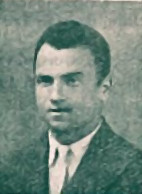Szymon Datner

Szymon Datner (
Life to 1945
In 1928 Datner settled in Białystok.[3] Before the outbreak of World War II, he worked as a physical-education teacher at a Jewish secondary school in Białystok. He lived in that city with his wife and two daughters through the Soviet occupation of eastern Poland. After the German attack on the Soviet Union, he was forced with his family into the Białystok Ghetto. On 24 May 1943 he helped smuggle several persons out of the Ghetto. However, his wife and daughters did not survive its liquidation.[citation needed]
Postwar career
After the war, Datner served for two years as head of the Białystok branch of the
The same year, the CŻKH published his Walka i zagłada Białostockiego Ghetta (The Struggle and Destruction of the Białystok Ghetto).
In 1969–70 he presided over
Family
His daughter is Helena Datner, Polish historian and sociologist specialising in the social history of Polish Jews and the anti-semitism in Poland.
Death
Datner died in 1989 in
Publications
- Walka i Zagłada białostockiego getta (Łódź, 1946)
- Zbrodnie Wehrmachtu na jeńcach wojennych w II wojnie światowej (Warsaw, 1961)
- Zbrodnie okupanta w czasie powstania warszawskiego w 1944 roku (w dokumentach) (Warsaw, 1962)
- Wilhelm Koppe - nieukarany zbrodniarz hitlerowski (Warsaw-Poznań, 1963)
- Ucieczki z niewoli niemieckiej 1939-1945 (Warsaw, 1966)
- Eksterminacja ludności żydowskiej w Okręgu Białostockim (Bulletin of the Jewish Historical Institute, Warsaw, October–December 1966, no. 60: pp. 3–29)
- Niemiecki okupacyjny aparat bezpieczeństwa w okręgu białostockim (1941–1944) w świetle materiałów niemieckich (opracowania Waldemara Macholla), Biuletyn GKBZH (Warsaw, 1965)
- 55 dni Wehrmachtu w Polsce (Warsaw, 1967)
- Las sprawiedliwych. Karta z dziejów ratownictwa Żydow w okupowanej Polsce ( Warsaw, 1968)
- Tragedia w Doessel - (ucieczki z niewoli niemieckiej 1939-1945 ciąg dalszy) (Warsaw, 1970)
- Z mądrości Talmudu (Warsaw, 1988)
References
- ISBN 978-0-253-01087-2.
- ^ Aleksiun - 2004 - Polish Historiography of the Holocaust—Between Silence and Public Debate.pdf, retrieved 2018-01-29
- ^ a b Poczykowski, Radosław & Katarzyna Niziołek. "Szymon Datner (1902-1989)". Szlak Dziedzictwa Żydowskiego w Białymstoku. Uniwersytet w Białymstoku. Retrieved 10 May 2011.
- ^ )
- ^ "Datner o zbrodniach hitlerowskich na Żydach zbiegłych z gett - Muzeum Historii Polski". muzhp.pl.
- ^ Bernd Wegner (1997), From Peace to War: Germany, Soviet Russia, and the World, 1939-1941, Militärgeschichtliches Forschungsamt, Berghahn Books, Germany, p. 54
- S2CID 142940545. Retrieved 2018-06-25.
- S2CID 212905113.
- ^ Hitler Strikes Poland: litzkrieg, Ideology, and Atrocity - Page 185 Alexander B. Rossino · University Press of Kansas 2003
External links
- Datner, Szymon. "German Nazi Crimes Against Jews Who Escaped From The Ghettoes "Legal" Threats And Ordinances Regarding Jews And The Poles Who Helped Them" (PDF). Jewish Historical Institute Bulletin No. 75 (1970).
